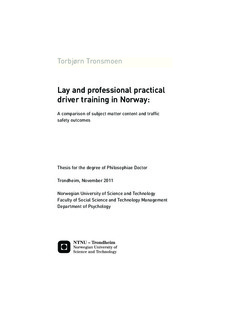| dc.contributor.author | Tronsmoen, Torbjørn | nb_NO |
| dc.date.accessioned | 2014-12-19T14:42:16Z | |
| dc.date.available | 2014-12-19T14:42:16Z | |
| dc.date.created | 2012-02-29 | nb_NO |
| dc.date.issued | 2011 | nb_NO |
| dc.identifier | 506588 | nb_NO |
| dc.identifier.isbn | 978-82-471-3154-1 | nb_NO |
| dc.identifier.uri | http://hdl.handle.net/11250/270773 | |
| dc.description.abstract | This thesis examines differences between formal and informal practical pre-licence driver training with regard to content, amount, and other didactical properties and associations with variables such as safety attitudes, self-assessment of driving ability, driver behaviour, and crash involvement. The aim of the thesis is to examine the association between psychological constructs and skills which are assumed to be influenced by driver training, and then to examine the relationships to crash involvement.
The thesis is based on a cross-sectional study of a representative sample of young Norwegian drivers aged 18–20 years holding a licence to drive passenger cars (n = 1419). The thesis is based on three scientific papers.
The theoretical basis for the thesis is theories of traffic behaviour and theories explaining accident involvement. The first study examines the psychometric quality of a new measurement instrument for self-assessment of driving ability. The results showed that young drivers’ self-assessment of their own driving ability is a multidimensional construct. There were differences among young drivers with regard to how they perceived their driving ability and safety skills when driving. One important contribution from the study is a “body dimension” of driving competence, as perceived by the young drivers. This body dimension is in line with several theories, although empirical support has been lacking in previous studies of self-assessment.
The second study examines and compares three different psychological constructs: safety attitudes, self-assessment, and self-reported driver behaviour, all with regard to associations with driver training as well as with crash involvement. The results showed that there were weak, but statistical significant associations between the actual constructs and practical driver training. The results with regard to associations with crash involvement were more convincing. The strongest variable to explain variance in accident involvement was exposure, followed by the dimensions safety orientation and the body dimension from the self-assessment instrument. Also, violation behaviour was statistically significant.
In the third study, the differences between formal and informal driver training were examined with regard to content and amount of training. The results showed substantial differences with regard to content and emphasis on elements in the training. Professional driver training emphasised nearly all the educational elements more heavily through the instruction compared to training given by lay instructors. The study also examined the relationship between didactical properties in the practical driver training and the dimensions of safety attitudes, self-assessment and driver behaviour. The results showed weak associations. However, the relationship between didactical properties and specific task skills, one of the dimensions within self-assessment, was fairly strong, accounting for more than 30% of the variance in specific task skills.
Possible implications of the results of the three studies are discussed with regard to the balance between formal and informal driver training, and also with regard to other educational consequences | nb_NO |
| dc.language | eng | nb_NO |
| dc.publisher | Norges teknisk-naturvitenskapelige universitet, Fakultet for samfunnsvitenskap og teknologiledelse, Psykologisk institutt | nb_NO |
| dc.relation.ispartofseries | Doktoravhandlinger ved NTNU, 1503-8181; 2011:291 | nb_NO |
| dc.relation.haspart | Tronsmoen, Torbjorn. Associations between self-assessment of driving ability, driver training and crash involvement among young drivers. Transportation Research Part F - Traffic Psychology and Behaviour. (ISSN 1369-8478). 11(5): 334-346, 2008. <a href='http://dx.doi.org/10.1016/j.trf.2008.02.002'>10.1016/j.trf.2008.02.002</a>. | nb_NO |
| dc.relation.haspart | Tronsmoen, Torbjorn. Associations between driver training, determinants of risky driving behaviour and crash involvement. Safety Science. (ISSN 0925-7535). 48(1): 35-45, 2010. <a href='http://dx.doi.org/10.1016/j.ssci.2009.05.001'>10.1016/j.ssci.2009.05.001</a>. | nb_NO |
| dc.relation.haspart | Tronsmoen, Torbjorn. Differences between formal and informal practical driver training as experienced by the learners themselves. Transportation Research Part F - Traffic Psychology and Behaviour. (ISSN 1369-8478). 14(3): 176-188, 2011. <a href='http://dx.doi.org/10.1016/j.trf.2010.11.009'>10.1016/j.trf.2010.11.009</a>. | nb_NO |
| dc.title | Lay and professional practical driver training in Norway: A comparison of subject matter content and traffic safety outcomes | nb_NO |
| dc.type | Doctoral thesis | nb_NO |
| dc.contributor.department | Norges teknisk-naturvitenskapelige universitet, Fakultet for samfunnsvitenskap og teknologiledelse, Psykologisk institutt | nb_NO |
| dc.description.degree | PhD i psykologi | nb_NO |
| dc.description.degree | PhD in Psychology | en_GB |
